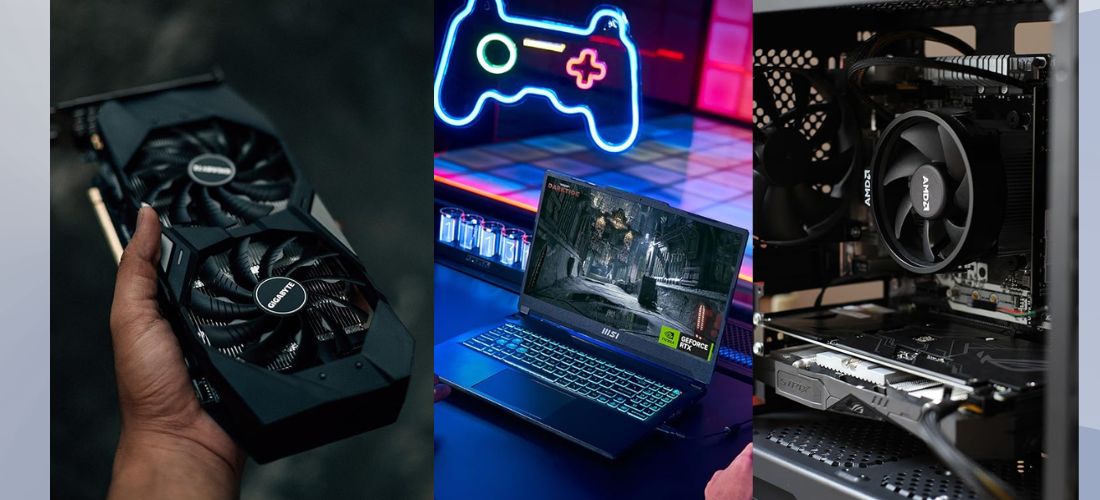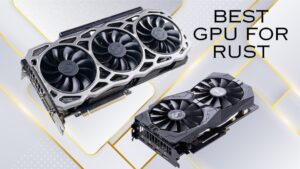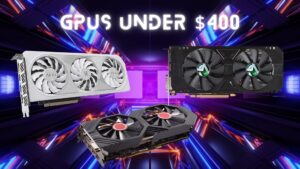Revolutionizing SolidWorks: The 6 Best GPUs in 2024
The world of design and engineering is constantly evolving, and SolidWorks has emerged as a powerful tool for professionals and enthusiasts alike. To harness the full potential of this 3D modelling and CAD software, having the right Graphics Processing Unit (GPU) is paramount. In this ever-advancing landscape, choosing the best GPUs for SolidWorks can be perplexing. Your GPU not only impacts your modelling and rendering capabilities but also determines how seamlessly you can navigate through intricate designs. In this article, we will delve into the world of graphic cards, exploring the best GPUs for SolidWorks. Whether you’re an architect, engineer, or a creative designer, finding the perfect GPU is crucial to unlocking a smoother, more efficient, and enjoyable SolidWorks experience.
Why the Best GPUs for SolidWorks Matter?
The choice of GPUs (Graphics Processing Units) for SolidWorks, a prominent CAD (Computer-Aided Design) software, is critical for several reasons. GPUs accelerate rendering, shading, and modelling tasks, significantly enhancing workflow efficiency. High-performance GPUs ensure smooth handling of complex designs, reducing lag and improving overall productivity. They enable real-time visualization of intricate models and simulations, crucial for design validation and client presentations. Compatibility with SolidWorks-certified GPUs ensures optimal software performance and stability, minimizing errors and maximizing design accuracy. Investing in the best GPUs for SolidWorks not only boosts rendering speeds and graphical fidelity but also supports future-proofing for evolving design demands and software updates, making it a strategic investment for professionals in engineering, architecture, and product development industries.
Top GPU Recommendations for SolidWorks:
1. NVIDIA Quadro RTX 5000:
- VRAM: 16 GB GDDR6
- CUDA Cores: 3,072

The NVIDIA Quadro RTX 5000 GPU is a powerful choice for running SolidWorks due to its specialized features tailored for professional CAD applications. Equipped with NVIDIA’s Turing architecture and RTX technology, the Quadro RTX 5000 delivers significant performance improvements in rendering, simulation, and real-time visualization tasks. Its dedicated CUDA cores and Tensor cores accelerate complex computations, enhancing workflow efficiency and reducing design iteration times.
For SolidWorks users, the Quadro RTX 5000 ensures smooth handling of large assemblies and intricate models, enabling real-time rendering and dynamic simulations without compromising accuracy. Its 16 GB of GDDR6 memory provides ample resources for loading and manipulating high-resolution textures and models, crucial for detailed design work and immersive visualization. Moreover, the Quadro RTX 5000 is certified by SolidWorks, ensuring compatibility and reliability with the software’s latest features and updates. This certification assures users that the GPU meets stringent performance standards and stability requirements, minimizing compatibility issues and maximizing productivity.
Pros:
- Excellent performance in professional CAD applications.
- Supports real-time ray tracing for superior visual fidelity.
- Reliable stability and compatibility with SolidWorks.
- Ample 16 GB GDDR6 memory for complex models.
- Efficient CUDA and Tensor cores for accelerated computations.
Cons:
- Higher cost compared to consumer-grade GPUs.
- Power-hungry and requires adequate cooling.
2. AMD Radeon Pro WX 7100 Best GPUs for SolidWorks:
- VRAM: 8 GB GDDR5
- Stream Processors: 2,304

The AMD Radeon Pro WX 7100 GPU is for SolidWorks users seeking reliable performance in professional CAD applications. With its Polaris architecture and 8 GB of GDDR5 memory, the Radeon Pro WX 7100 offers competitive performance in handling complex designs and simulations. It excels in tasks such as rendering, modelling, and real-time visualization, providing smooth operation even with large assemblies and detailed textures. SolidWorks users benefit from the Radeon Pro WX 7100 certification, ensuring compatibility and optimized performance with the software’s latest features and updates. This certification guarantees stability and reliability, crucial for maintaining workflow efficiency and minimizing downtime.
The GPU’s 8 GB of memory supports efficient data handling and manipulation of high-resolution models, enhancing productivity in design iterations and collaboration. It also features AMD’s advanced GPU technologies, such as AMD Eyefinity for multi-display setups and OpenCL support for accelerating compute-intensive tasks. However, potential drawbacks include its higher power consumption and thermal output compared to consumer-grade GPUs, requiring adequate cooling in workstation setups. Additionally, while proficient in professional CAD tasks, it may not offer the same level of real-time ray tracing capabilities as higher-end workstation GPUs.
Pros:
- Reliable performance for professional CAD and design tasks.
- 8 GB GDDR5 memory supports complex models and textures.
- Certified for optimized compatibility with SolidWorks software.
- Supports AMD Eyefinity for multi-display configurations.
- Competitive price point compared to other workstation GPUs.
Cons:
- Higher power consumption and thermal output.
- Limited real-time ray tracing capabilities compared to higher-end GPUs.
3. NVIDIA Quadro P2000:
- VRAM: 5 GB GDDR5
- CUDA Cores: 1,024

The NVIDIA Quadro P2000 GPU is a solid choice for professionals using SolidWorks, offering a balance of performance, reliability, and affordability. Built on NVIDIA’s Pascal architecture and equipped with 5 GB of GDDR5 memory, the Quadro P2000 delivers efficient performance for CAD and design applications. It handles tasks such as modelling, rendering, and simulation with ease, supporting complex designs and large assemblies.
SolidWorks users benefit from the Quadro P2000 certification, ensuring optimized compatibility and stability with the software. This certification guarantees that the GPU meets rigorous performance standards, minimizing compatibility issues and maximizing productivity.
The 5 GB of GDDR5 memory provides ample resources for manipulating high-resolution textures and detailed models, facilitating smooth workflow and design iteration. Additionally, the Quadro P2000 supports NVIDIA’s advanced technologies like CUDA cores for parallel processing and Quadro Sync for multi-display setups, enhancing productivity and workflow efficiency. However, potential drawbacks include its limited 5 GB memory size for very large models and its moderate thermal and power consumption requirements, which may necessitate adequate cooling in workstation configurations.
Pros:
- Efficient performance for SolidWorks and CAD applications.
- Certified for optimized compatibility and stability.
- 5 GB GDDR5 memory handles complex designs effectively.
- Supports NVIDIA CUDA cores for parallel processing.
- Cost-effective compared to higher-end workstation GPUs.
Cons:
- Limited to 5 GB memory for very large models.
- Requires adequate cooling due to moderate thermal output.
4. EVGA GeForce RTX 2080 Ti Best GPUs for SolidWorks:
- VRAM: 11GB GDDR6
- CUDA Cores: 4352

The EVGA GeForce RTX 2080 Ti GPU offers exceptional performance for SolidWorks users, leveraging NVIDIA’s Turing architecture and RTX technology to enhance CAD and design workflows. With 11 GB of GDDR6 memory and dedicated Tensor cores, the RTX 2080 Ti excels in handling complex simulations, rendering tasks, and real-time visualizations with high precision and efficiency. This GPU supports real-time ray tracing, delivering realistic lighting, shadows, and reflections to enhance design visualization and accuracy.
SolidWorks users benefit from the RTX 2080 Ti’s robust performance, enabling smooth operation even with large assemblies and intricate models. The GPU’s CUDA cores accelerate compute-intensive tasks, further improving workflow efficiency and productivity.
However, despite its impressive capabilities, the RTX 2080 Ti is primarily designed for gaming and lacks official certification for professional CAD applications like SolidWorks. This lack of certification means users may encounter compatibility issues or require additional troubleshooting compared to certified workstation GPUs. Additionally, the RTX 2080 Ti’s high power consumption and thermal output may necessitate robust cooling solutions in workstation configurations to maintain optimal performance and reliability.
Pros:
- Exceptional performance in CAD and real-time rendering.
- 11 GB of GDDR6 memory supports large models.
- Supports real-time ray tracing for realistic visuals.
- NVIDIA CUDA cores accelerate compute-intensive tasks.
- Dual-slot design is suitable for most workstation setups.
Cons:
- Lacks official certification for SolidWorks and professional CAD.
- High power consumption and requires robust cooling solutions.
5. PNY Quadro RTX 4000:
- VRAM: 8GB GDDR6
- CUDA Cores: 2304

The PNY Quadro RTX 4000 is a highly recommended GPU for SolidWorks due to its powerful performance, advanced features and reliability tailored for CAD and design applications. Built on NVIDIA’s Turing architecture and equipped with 8 GB of GDDR6 memory, the Quadro RTX 4000 delivers powerful performance for handling complex models, simulations, and real-time rendering tasks with precision and efficiency.
SolidWorks users benefit from the Quadro RTX 4000 certification, ensuring optimized compatibility and stability with the software. This certification guarantees reliable performance and minimizes potential compatibility issues, providing peace of mind for users working on critical projects.
The 8 GB of GDDR6 memory provides ample capacity for manipulating large datasets and detailed textures, facilitating smooth workflow and iterative design processes. Additionally, the Quadro RTX 4000 features NVIDIA’s advanced RT cores for real-time ray tracing and Tensor cores for AI-enhanced workflows, enhancing visualization and simulation capabilities. However, potential drawbacks include its moderate power consumption and thermal output, which may require adequate cooling solutions in workstation configurations. Additionally, while proficient in professional CAD tasks, it may not offer the same level of gaming performance as consumer-grade GPUs.
Pros:
- Powerful performance for CAD and real-time rendering.
- 8 GB of GDDR6 memory supports complex models.
- Certified for optimized compatibility with SolidWorks.
- Supports real-time ray tracing and AI-enhanced workflows.
- Reliable stability for professional design and simulation tasks.
Cons:
- Moderate power consumption; may require adequate cooling.
- Higher cost compared to consumer-grade GPUs.
6. ZOTAC GeForce RTX 2060 Best GPUs for SolidWorks:
- VRAM: 6GB GDDR6
- CUDA Cores: 1920

The ZOTAC GeForce RTX 2060 GPU offers a balanced option for SolidWorks users seeking good performance at a competitive price point. Powered by NVIDIA’s Turing architecture and featuring 6 GB of GDDR6 memory, the RTX 2060 is capable of handling CAD and design tasks effectively. It provides sufficient power for modelling, rendering, and basic simulation tasks, making it suitable for professionals and enthusiasts alike.
While the RTX 2060 lacks official certification for SolidWorks, it can still deliver reliable performance in many CAD applications. Its CUDA cores accelerate parallel processing tasks, enhancing workflow efficiency and productivity. The 6 GB of GDDR6 memory supports moderate-sized models and textures, facilitating smooth design iterations and visualization.
However, compared to higher-end Quadro GPUs, the RTX 2060 may exhibit limitations in complex simulations and large-scale projects. Its gaming-centric design means it may not offer the same level of optimized performance and stability as workstation-class GPUs certified for professional CAD use.
Pros:
- An affordable option for CAD and design tasks.
- 6 GB of GDDR6 memory supports moderate models.
- NVIDIA Turing architecture for efficient performance.
- CUDA cores accelerate parallel processing tasks.
- Suitable for gaming and multimedia applications.
Cons:
- Lacks official certification for professional CAD software.
- May have limitations in complex simulations and large projects.
Factors to Consider:
Selecting the Best GPUs for SolidWorks needs requires careful consideration. Here are some essential factors to keep in mind:
GPU Compatibility
- Ensure that the GPU you choose is compatible with SolidWorks. Check the official SolidWorks system requirements to make sure your GPU is on the list.
VRAM Capacity
- A GPU with ample VRAM is crucial for handling large assemblies and complex simulations. Aim for a minimum of 8GB to 16GB of VRAM for optimal performance.
CUDA Cores
- The number of CUDA cores directly impacts the GPU’s parallel processing capabilities. More CUDA cores mean faster rendering and smoother interactions.
Driver Support
- Ensure that the GPU you choose has excellent driver support for SolidWorks. NVIDIA and AMD both offer certified drivers for their professional GPUs.
Budget
- Your budget plays a significant role in your GPU selection. While professional GPUs offer the best performance, consumer-grade GPUs like the GeForce series can also deliver impressive results at a lower cost.
Conclusion
Selecting the optimal GPU for SolidWorks is crucial for maximizing productivity and efficiency in design and engineering. Each GPU in the 2024 lineup offers unique strengths tailored to meet the demands of CAD software, from rendering complex models to enhancing real-time visualization. Whether prioritizing performance, affordability, or specific features like real-time ray tracing, the right choice hinges on aligning GPU capabilities with professional needs. Investing in a GPU certified for SolidWorks ensures compatibility and stability, crucial for minimizing errors and maximizing workflow efficiency. By carefully considering factors such as CUDA cores, VRAM capacity, and thermal requirements, professionals can make informed decisions that elevate their SolidWorks experience, supporting seamless design iteration and collaborative efforts in various industries.
FAQs
1. What is the minimum GPU requirement for SolidWorks?
The minimum GPU requirement for SolidWorks varies depending on the version and your specific needs. Check the official SolidWorks system requirements for the most accurate information.
2. Can I use a gaming GPU for SolidWorks?
While gaming GPUs can work with SolidWorks, it’s recommended to use workstation-class GPUs for optimal performance and stability.
3. Do I need a high-end GPU for 2D modelling in SolidWorks?
For basic 2D modelling tasks, a mid-range GPU should suffice. However, if you plan to work with large assemblies or perform 3D rendering, investing in a higher-end GPU is advisable.
4. How often should I update my GPU for SolidWorks?
The frequency of GPU updates depends on your usage and budget. Generally, it’s a good idea to update your GPU every 2-3 years to keep up with software advancements.
5. Are external GPUs (eGPUs) compatible with SolidWorks?
Yes, eGPUs can be used with SolidWorks, but compatibility may vary. Ensure that your eGPU is supported by your computer and has the necessary drivers for SolidWorks.
Last Updated on 22 January 2025 by Ansa Imran

Ansa Imran, a writer, excels in creating insightful content about technology and gaming. Her articles, known for their clarity and depth, help demystify complex tech topics for a broad audience. Ansa’s work showcases her passion for the latest tech trends and her ability to engage readers with informative, well-researched pieces.







